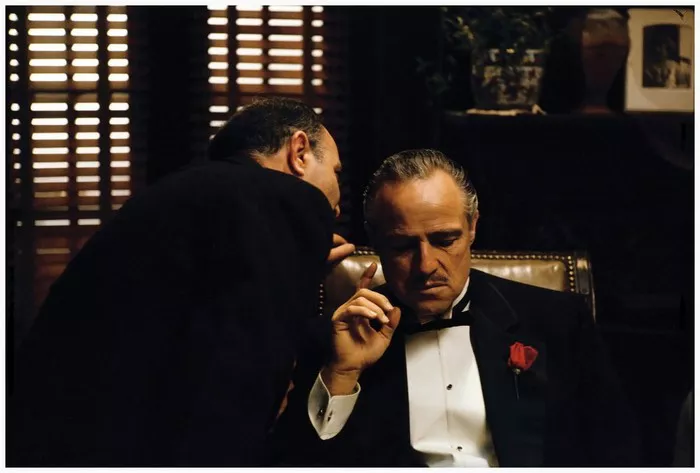In the vast tapestry of cinematic history, certain films emerge not merely as entertainment but as timeless works of art that transcend generations. “The Godfather,” directed by Francis Ford Coppola and released in 1972, stands as an unparalleled example of cinematic greatness. As we delve into the reasons Why The Godfather Is A Great Movie, we unravel the layers of its narrative, explore its cultural impact, and examine the enduring legacy that cements its status as a masterpiece.
I. Crafting a Cinematic Masterpiece: The Artistry of Storytelling
1. The Power of Adaptation: Transforming Puzo’s Novel
At the heart of “The Godfather” lies Mario Puzo’s novel of the same name, a source material that Coppola masterfully adapted for the screen. The seamless translation of the novel’s intricate narrative to a visual medium showcases the director’s skill in distilling complex themes, character dynamics, and moral dilemmas into a compelling cinematic experience.
2. Pacing and Structure: The Elegance of Narrative Flow
“The Godfather” exhibits a narrative elegance that is as mesmerizing as it is strategic. The film’s pacing, characterized by a deliberate and unhurried progression, allows the audience to immerse themselves in the Corleone family saga. The interweaving of multiple storylines, coupled with expertly placed moments of tension and resolution, contributes to a storytelling cadence that keeps viewers engaged from the opening scene to the closing credits.
II. The Power of Performances: Iconic Characters Brought to Life
1. Marlon Brando’s Vito Corleone: A Performance for the Ages
Central to the film’s success is Marlon Brando’s iconic portrayal of Don Vito Corleone. Brando’s nuanced performance, characterized by the raspy voice, subtle gestures, and a commanding presence, elevates Vito Corleone beyond a mere character and into the realm of cultural iconography. His depiction of the patriarch remains a touchstone for actors and audiences alike.
2. Al Pacino’s Michael Corleone: A Journey of Transformation
Al Pacino’s portrayal of Michael Corleone is a study of character evolution. From a reluctant outsider to the ruthless head of the Corleone family, Pacino navigates Michael’s complex journey with a subtlety that is both captivating and haunting. The character’s transformation becomes a central narrative thread, and Pacino’s performance is a tour de force that contributes significantly to the film’s impact.
III. Cinematic Innovation: Capturing Mood and Atmosphere
1. Cinematography by Gordon Willis: A Visual Symphony
Gordon Willis, the cinematographer often referred to as the “Prince of Darkness,” employs a distinctive visual style that becomes synonymous with “The Godfather.” The play of shadows, low-key lighting, and the careful composition of each frame contribute to the film’s atmospheric richness. Willis’ cinematography doesn’t merely capture scenes; it shapes the very mood and tone of the narrative.
2. Nino Rota’s Score: A Musical Tapestry of Emotion
Nino Rota’s haunting score for “The Godfather” is a crucial element in creating the film’s emotional resonance. The iconic theme, accompanied by the use of traditional Italian music, becomes a character in itself, evoking a range of emotions from nostalgia to tension. Rota’s contribution to the film’s auditory landscape is a testament to the power of music in enhancing storytelling.
IV. Cultural Impact: The Godfather’s Enduring Resonance
1. Influencing Pop Culture: Beyond the Silver Screen
“The Godfather” has transcended its status as a film to become a cultural touchstone. Its quotes, characters, and scenes have permeated popular culture, influencing subsequent generations of filmmakers, writers, and artists. The film’s impact extends to references in television, literature, and even political discourse, solidifying its place in the collective consciousness.
2. The Godfather’s Legacy: A Cinematic Standard-Bearer
As the years pass, “The Godfather” continues to be a benchmark against which other films are measured. Its enduring legacy is evident in critical assessments, retrospectives, and the continued reverence from audiences worldwide. The film’s status as a standard-bearer for cinematic excellence reaffirms its greatness across changing cultural landscapes.
Conclusion: The Enduring Allure of The Godfather
In conclusion, the greatness of “The Godfather” lies not in a singular aspect but in the convergence of storytelling prowess, unparalleled performances, cinematic innovation, and a cultural impact that resonates through time. The film’s ability to evoke a myriad of emotions, explore the complexities of power and family, and transcend the confines of its era cements its place as a cinematic treasure.
“The Godfather” isn’t merely a movie; it’s an experience—a journey through the intricacies of human nature, morality, and the indelible marks left by choices. As audiences revisit this cinematic masterpiece, they are reminded that its greatness isn’t confined to a specific era but continues to captivate, challenge, and inspire—an enduring testament to the power of storytelling and the artistry of those who craft it.
In a landscape crowded with films, “The Godfather” stands tall, an immortal work of art that invites viewers to witness the convergence of narrative brilliance, visual poetry, and timeless themes. As the Corleone legacy echoes through the corridors of cinematic history, “The Godfather” remains not just a great movie but a transcendent testament to the boundless possibilities of storytelling on the silver screen.

